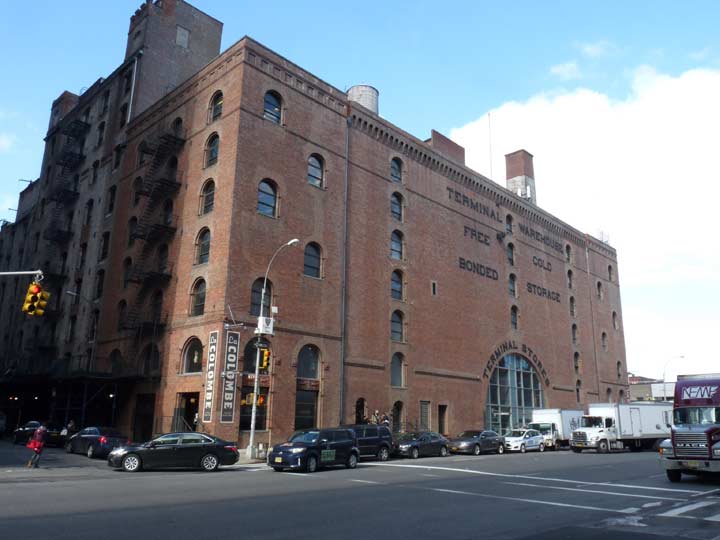
The hulking, fortress-like brick Terminal Warehouse at 11th Avenue and West 28th Street was constructed in 1890 with a design known as American Round Arch by architect George Mallory on land purchased by industrialist William Wickes Rossiter. His brother, E. V. W. Rossiter , was Treasurer of the New York Central Railroad, the railroad that had trundled down the centers of 10th and 11th Avenue, carrying goods between the factories and warehouses then bustling on the west side of town, and the ships that brought those goods to NYC docked on the Hudson River. Mallory created an immense hulk that was actually an amalgamation of 25 separate structures within the exterior wall.
Rossiter’s massive Terminal Warehouse offered shipping, warehousing and moving and packing spaces all in one building. Massive arches on the 11th and 12th Avenue ends admitted freight trains as spurs from the tracks running down the center of 11th Avenue, and coming in from shoreside on 12th Avenue, and easy admittance for goods. The Warehouse offered cold storage during summers in an era when private refrigeration was not as common as it became later in the 20th Century. Metallic letters preserved on the facade still advertise it. The Warehouse also specialized in the storage of large, bulky stage sets used in Broadway productions. However, the Warehouse was conflagration-prone and thousands of dollars of goods, including some of the stage sets, were lost to fire in the early days.
Unfortunately, W. W. Rossiter passed away from intestinal cancer in 1897 at age 49. The Warehouse lasted for many decades as a storage venue; in the 1980s, it played host to the famed Tunnel nightclub. As Chelsea began to gentrify the huge building contained dozens of art galleries.
Yet more changes came in 2016 as the complex’s owners wished to emulate the success of the Chelsea Market a few blocks south, which is the old Nabisco bakery that has been converted to offices on the upper floors and a food court with some retail on the bottom floor. While taxi service Uber has its offices on the upper floors, eateries/drinkeries like Porchlight and La Colombe have opened on the ground floor.
Info from Daytonian in Manhattan and Curbed
Check out the ForgottenBook, take a look at the gift shop, and as always, “comment…as you see fit.”
3/27/18
